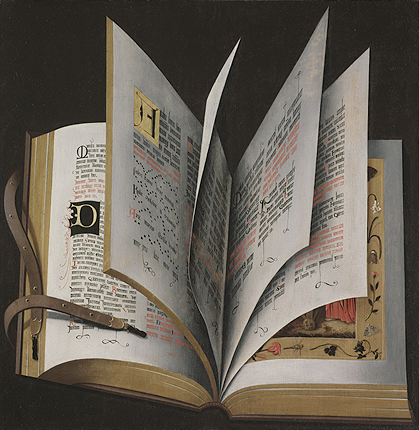Today’s post comes from Joe Brichacek, Class of 2012 and Art Center Student Docent.

The Open Missal has long been a favorite in the Frances Lehman Loeb Art Center’s collection. It is both stunningly realistic and highly symbolic. Indeed, the more time you spend with the work, the more details you find, and the more insight you are able to glean. Even the attribution to the German artist Ludger tom Ring the Younger is due to a small detail in the fictive text that reads “Ludevi Rinki,” and many other beautiful and meaningful facets crowd the composition: The large margins of the pages show the opulence of those that could afford large amounts of paper. Similarly, the straps remind us that books have not always been simply checked out of a local library, they were precious items kept under lock and key. The flowers and insects on the right of the composition anticipate the later genre of Northern European floral art, of which Ludger tom Ring was a progenitor. These allegorical flowers and insects frame an image which is largely obscured by a moving page, but the skull at the bottom readily indicates that the image is a crucifixion scene. Even the music notes provide an example of contemporaneous worship practice amongst German Catholics.
While the artistic abilities of Ludger tom Ring speak for themselves, one must wonder why The Open Missal was painted at all. Presumably, Ludger tom Ring was not just showing off. The key to understanding The Open Missal is the movement we sense in the work. While the painting appears to be an early version of a “snap-shot,” it is really quite fluid. Not only does the composition cause your eyes to dart about, soaking up each element of the colorful missal, but it is rendered as if someone has just tapped the front cover of the book, causing some of the pages to gracefully flip from left to right. It is significant that the pages we can see on the left are covered with illuminated manuscript and the page on the farthest right is the aforementioned crucifixion scene. The idea that Christ had been prophesied in text and then manifested in flesh is thus allegorically rendered by the movement of pages in this seemingly straightforward painting of a liturgical text as words become flesh. This facet of Ludger tom Ring’s cosmology would have been incredibly important for him as a Catholic in sixteenth-century Germany. Thus, while The Open Missal is an immensely beautiful painting, it is also a meaningful historical, cultural, and personal artifact, a true treasure in the Art Center’s collection.





mmmm very nice i think
who s is the author?